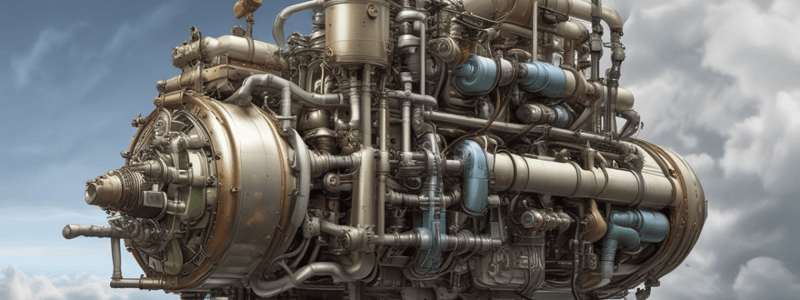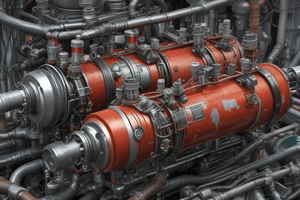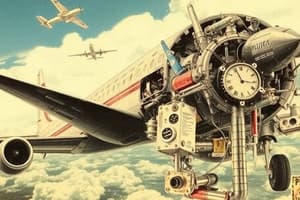Podcast
Questions and Answers
What happens when a differential pressure is sensed between the filter inlet and outlet pressures?
What happens when a differential pressure is sensed between the filter inlet and outlet pressures?
- The gears in the spur gear pump stop rotating
- The fuel pump shuts down
- The cockpit warning light turns off
- A flag or button pops out of the filter bowl (correct)
What is the purpose of engine-driven fuel pumps?
What is the purpose of engine-driven fuel pumps?
- To provide fuel only during low engine operating settings
- To reduce the flow capacity to match maximum engine requirements
- To increase hydraulic locking in the fuel system
- To ensure that engine demands never exceed fuel supply volume (correct)
How do spur gear pumps operate?
How do spur gear pumps operate?
- By increasing hydraulic locking in the system
- By meshing two steel gears driven by the engine (correct)
- By using only one gear and one bush enclosed in a housing
- By stopping the rotation of the gears when fuel is drawn into the pump
Why are fuel pumps typically rated at greater flow capacity than maximum engine requirements?
Why are fuel pumps typically rated at greater flow capacity than maximum engine requirements?
What is the purpose of having relief slots machined in the teeth of spur gear pumps?
What is the purpose of having relief slots machined in the teeth of spur gear pumps?
What component is responsible for changing the pump displacement in the variable displacement pump described in the text?
What component is responsible for changing the pump displacement in the variable displacement pump described in the text?
What is the purpose of paralleling the fuel pump in a gas turbine engine?
What is the purpose of paralleling the fuel pump in a gas turbine engine?
How is the reciprocating motion imparted to the plungers in the variable displacement pump?
How is the reciprocating motion imparted to the plungers in the variable displacement pump?
What is the significance of the paralleling valve closing at 16% RPM?
What is the significance of the paralleling valve closing at 16% RPM?
What is mechanically linked to the cam-plate in the variable displacement pump?
What is mechanically linked to the cam-plate in the variable displacement pump?
What happens when the secondary pump check valve opens?
What happens when the secondary pump check valve opens?
In the variable displacement pump, what causes the servo piston to move and alter the pump stroke and delivery?
In the variable displacement pump, what causes the servo piston to move and alter the pump stroke and delivery?
Why does the secondary pump pressure switch close when fuel pressure reaches 150 PSI?
Why does the secondary pump pressure switch close when fuel pressure reaches 150 PSI?
How does a fuel control unit integrate with a variable flow pump according to the text?
How does a fuel control unit integrate with a variable flow pump according to the text?
What is the function of the centrifugal boost pump in the fuel system?
What is the function of the centrifugal boost pump in the fuel system?
Which pump can satisfy most engine requirements?
Which pump can satisfy most engine requirements?
What is the flow capacity of the primary pump?
What is the flow capacity of the primary pump?
When does the pump assembly revert to series mode for normal engine operation?
When does the pump assembly revert to series mode for normal engine operation?
What type of valve is mounted on the pump assembly to enable paralleling of the fuel pumps?
What type of valve is mounted on the pump assembly to enable paralleling of the fuel pumps?
What is the purpose of the externally mounted low pressure filter in relation to the boost pump?
What is the purpose of the externally mounted low pressure filter in relation to the boost pump?
What does the engine speed sensitive control do between 16% and 65% RPM?
What does the engine speed sensitive control do between 16% and 65% RPM?
What creates a path directly to the primary pump during low rotational speeds in the fuel system?
What creates a path directly to the primary pump during low rotational speeds in the fuel system?
What is the relationship between primary pump volume and secondary pump volume?
What is the relationship between primary pump volume and secondary pump volume?
What happens to the pumps when they are operating in parallel?
What happens to the pumps when they are operating in parallel?
How does the secondary pump react when it cannot move all the fuel delivered by the boost pump?
How does the secondary pump react when it cannot move all the fuel delivered by the boost pump?
What activates the cockpit warning light to indicate that the fuel pumps are in parallel mode?
What activates the cockpit warning light to indicate that the fuel pumps are in parallel mode?
What is the sequence of fuel flow below 16% RPM in the engine start process?
What is the sequence of fuel flow below 16% RPM in the engine start process?
When does the fuel shut-off valve at the fuel control unit open during engine start?
When does the fuel shut-off valve at the fuel control unit open during engine start?
What is the purpose of the high pressure cock at the fuel control unit?
What is the purpose of the high pressure cock at the fuel control unit?
Which component recirculates fuel back through the pump assembly until 16% RPM is reached during an engine start?
Which component recirculates fuel back through the pump assembly until 16% RPM is reached during an engine start?
What is the function of the fuel pump servo piston?
What is the function of the fuel pump servo piston?
How is the throttle valve controlled in the fuel control unit (FCU)?
How is the throttle valve controlled in the fuel control unit (FCU)?
What is the role of the bellows assembly connected to the inlet pressure bellows?
What is the role of the bellows assembly connected to the inlet pressure bellows?
Why is the FCU control piston essential in the fuel system?
Why is the FCU control piston essential in the fuel system?
What is the purpose of having spill valves connected to the pressure control assembly and engine speed governor?
What is the purpose of having spill valves connected to the pressure control assembly and engine speed governor?
How does the high-pressure cock differ from the throttle valve in the fuel system?
How does the high-pressure cock differ from the throttle valve in the fuel system?
What determines the amount of fuel delivered to the engine by the fuel pump?
What determines the amount of fuel delivered to the engine by the fuel pump?
Which component is influenced by both spring assistance and pump discharge pressure through a restrictor?
Which component is influenced by both spring assistance and pump discharge pressure through a restrictor?
What is the primary role of the spindle valve in the fuel system?
What is the primary role of the spindle valve in the fuel system?
How does the balancing bellows assist in controlling fuel flow?
How does the balancing bellows assist in controlling fuel flow?
Study Notes
Fuel Pump Operation
- A flag or button pops out of the filter bowl or a cockpit warning light illuminates when a differential pressure is sensed between filter inlet and outlet pressures.
- Engine-driven fuel pumps, also known as high-pressure fuel pumps, deliver a continuous supply of fuel at the desired volume during all engine operating settings.
- Fuel pumps are typically rated at greater flow capacity than maximum engine requirements to ensure that engine demands never exceed fuel supply volume.
Types of Engine-Driven Fuel Pumps
- There are two types of engine-driven fuel pumps: spur gear and piston (variable displacement).
- Spur gear pumps consist of two steel gears, with one being driven by the engine and the other gear meshing with the driven gear.
- Each gear is supported by bronze bushes enclosed in a closely fitted housing.
Spur Gear Pump Operation
- When the gears are rotated, fuel is drawn into the pump and carried round between the teeth and the pump case and delivered to the outlet side of the pump.
- Each tooth has a relief slot machined in it to prevent hydraulic locking.
Piston (Variable Displacement) Pump
- The variable displacement pump differs from the constant displacement gear type pump because pump displacement is changed to meet the varying fuel flow requirements without changing the pump's speed.
- Movement of the rotor imparts a reciprocating motion to the plungers, thus producing a pumping action.
- The action can be infinitely varied by the inclination of a cam-plate to alter the length of plunger stroke.
Fuel Pump Assembly and Operation
- The fuel pump and filter assembly includes a centrifugal boost pump, two spur gear delivery elements, and a high-pressure fuel filter.
- The centrifugal boost pump receives fuel from the fuel tank boost pump and increases its pressure sufficiently to ensure a positive supply to the gear elements.
- Boost pump pressure is filtered by an externally mounted low-pressure filter.
- The two gear elements are identified as the primary and secondary pumps.
- Either element can satisfy most engine requirements.
- The primary pump has a flow capacity of 11.6 US gallons per minute, and the secondary pump has a flow capacity of 10.4 US gallons per minute.
- Parallel operation is used to develop a higher flow rate during engine starting, when pump rotation is slow.
- The pump assembly reverts to series mode above 65% engine RPM for normal engine operation.
Fuel Pump Operation Below 16% RPM
- During an engine start, the gear elements are in series mode until the engine reaches 16% RPM.
- There is no fuel flow to the engine below 16% RPM because fuel flow and ignition are sequenced simultaneously by an engine speed-sensitive control at 16%.
- Fuel flow takes the following path: from the centrifugal boost pump, through the low-pressure fuel filter, through the secondary pump, through the open paralleling valve port, through the primary pump, and through the high-pressure fuel filter and on to the fuel control unit.
Fuel Pump Operation Between 16% and 65% RPM
- At 16% engine RPM, the paralleling valve is energized, and the fuel pumps are in parallel mode.
- The secondary pump pressure switch closes when fuel pressure downstream of the secondary pump reaches 150 PSI.
- This illuminates a cockpit light indicating that the pump is in parallel mode.
Studying That Suits You
Use AI to generate personalized quizzes and flashcards to suit your learning preferences.
Description
Learn about various components of aircraft fuel systems, such as flag or button pop-outs, cockpit warning lights, and engine-driven fuel pumps. Understand the functions of these components in maintaining fuel pressure and flow during different operating conditions.




